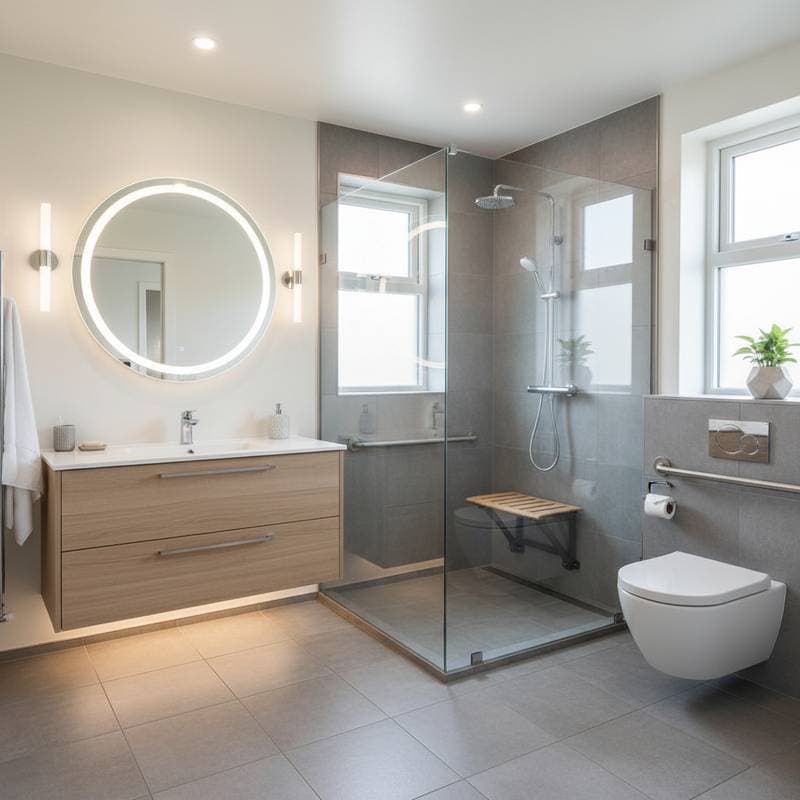Introduction to Japandi Wet Rooms
Japandi design emerges as a harmonious blend of Japanese minimalism and Scandinavian functionality, influencing bathroom trends for 2025. Wet rooms in this style feature open, barrier-free layouts fully sealed against water, creating seamless and serene environments. Homeowners appreciate the calm aesthetic that promotes relaxation while ensuring practical use.
These spaces eliminate traditional shower enclosures, allowing water to flow freely across the floor toward integrated drains. Natural materials like wood accents, stone surfaces, and neutral-toned tiles dominate the palette, evoking tranquility. Proper execution demands expert waterproofing to prevent moisture damage, making these rooms both beautiful and resilient.
Key Design Elements
Japandi wet rooms emphasize simplicity and quality. Walls and floors receive specialized membranes or coatings to achieve complete waterproofing, often layered beneath tiles for invisibility. Fixtures integrate subtly, such as recessed lighting and floating vanities that maintain clean lines.
Material selection plays a central role. Opt for porcelain or ceramic tiles in soft grays, whites, or earth tones to reflect light and expand the sense of space. Incorporate sustainable woods like oak or bamboo for shelving and accents, treated for humidity resistance. Rainfall showerheads mounted overhead provide a gentle cascade, enhancing the spa-like experience without overwhelming the minimal design.
Lighting contributes to the mood. Layer ambient sources with task-oriented options, such as sconces beside mirrors. Warm LED bulbs mimic natural daylight, fostering a welcoming atmosphere. These elements combine to craft bathrooms that feel expansive yet intimate.
Costs and Investment Considerations
Creating a Japandi wet room involves thoughtful budgeting, as specialized features drive expenses. Initial outlays cover materials, fixtures, and skilled labor, but the design yields lasting value through reduced upkeep.
Material Expenses
- Tile and Grout: High-quality porcelain tiles vary in cost from moderate to premium ranges, depending on size and finish. Installation proves labor-intensive, requiring a precise floor slope of about one-quarter inch per foot toward the drain to ensure efficient water runoff.
- Waterproofing Systems: Membranes, sealants, and underlayments add to the budget, typically ranging from essential liquid-applied options to advanced sheet-based barriers. These protect subfloors and walls, preventing costly water intrusion.
- Natural Accents: Wood or stone elements, such as teak benches or marble vanities, introduce warmth but demand moisture-resistant treatments to maintain integrity.
Fixture and Labor Breakdown
- Fixtures: Wall-mounted faucets, rain-style showerheads, and concealed thermostatic valves enhance the sleek profile while increasing costs due to custom plumbing integrations.
- Labor: Installation demands higher fees because precision governs every step, from calculating slopes with laser levels to custom tile cutting for curved areas. Expect involvement from plumbers, tilers, and waterproofing specialists, often spanning several weeks.
Although upfront costs exceed those of conventional bathrooms by 20 to 50 percent, long-term savings arise from superior durability. Owners avoid repairs for cracked grout, leaking enclosures, or subfloor rot, preserving structural integrity over time.
Homeowner-Contractor Communication Strategies
Effective collaboration forms the foundation of any wet room project, coordinating multiple trades for flawless results. Homeowners benefit from proactive dialogue to align visions and timelines.
Essential Preparation Steps
- Request Detailed Blueprints: Insist on comprehensive drawings that illustrate drain positions, tile layouts, and fixture elevations. These visuals clarify spatial flow and prevent on-site adjustments.
- Establish Project Guidelines: Address potential disruptions early, including construction noise, material storage, and end-of-day cleanups. Define timelines to manage expectations realistically.
- Verify Certifications and Warranties: Confirm that waterproofing installations meet manufacturer standards, qualifying for extended guarantees. Certified professionals ensure compliance with building codes.
- Maintain Thorough Records: Collect all estimates, invoices, and progress photos. This documentation safeguards against disputes and supports future claims.
Such practices foster trust and minimize delays, leading to a smoother renovation process.
Enduring Advantages
Beyond aesthetics, Japandi wet rooms deliver practical enhancements for daily life and property enhancement. The barrier-free design facilitates universal access, ideal for aging residents or those with mobility needs, as level floors reduce fall risks.
Waterproofing extends protection to the home's framework, shielding against mold and structural weakening. Materials withstand humidity and frequent cleaning, retaining appearance with minimal effort. Routine maintenance involves simple wiping and occasional resealing, far less demanding than enclosed showers.
In real estate terms, these bathrooms appeal to discerning buyers seeking modern, adaptable features. The timeless Japandi style transcends trends, adding perceived value through its blend of elegance and utility. Properties with such upgrades often command higher offers in competitive markets.
Steps to Realize Your Vision
Embarking on a Japandi wet room renovation requires strategic planning to balance design aspirations with functional needs. Begin by assessing your space: measure dimensions, evaluate plumbing access, and consider usage patterns for family members.
Consult experienced contractors specializing in wet room conversions. Review portfolios for Japandi-inspired projects to gauge expertise. Develop a mood board with material samples to guide selections, ensuring cohesion.
During construction, monitor progress through scheduled check-ins. Test waterproofing integrity post-installation with professional inspections. Final touches, like adjustable shelving or aromatherapy diffusers, personalize the space.
Ultimately, a Japandi wet room evolves into a enduring sanctuary, merging beauty with reliability. This investment elevates daily routines, offering serenity that endures for generations.










